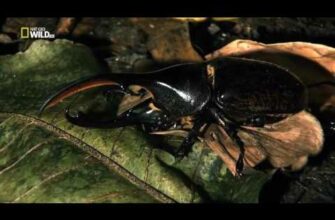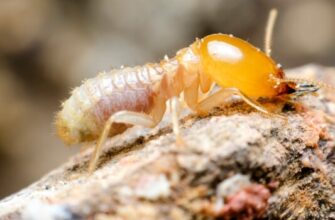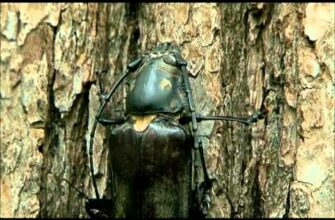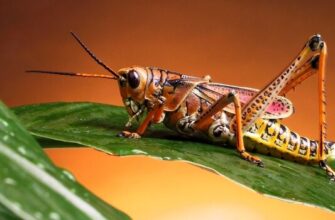Admiral Butterfly is a bright representative of Lepidoptera. It can often be found on forest edges, in city parks. The Latin name of these nymphalids is no less sonorous — Vanessa atalanta, scientifically described in 1758 by the Swedish naturalist C. Linnaeus.
Origin of the species and description
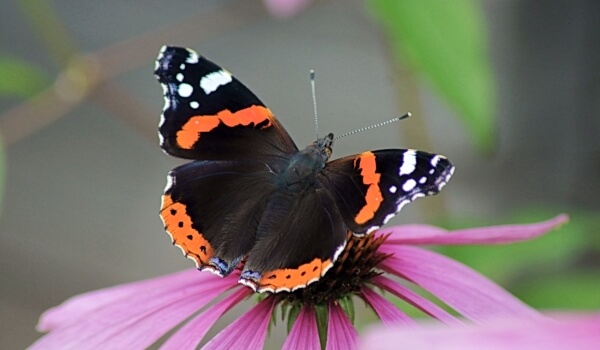
Photo: Admiral Butterfly
Lepidopterologists, people who devoted their lives to butterflies, often give them names associated with mythology. Our beauty got her Latin name atalanta, having inherited it from the daughter of the king of Arcadia, whom her parents, expecting the birth of a son, threw into the forest, where she was raised by a bear.
Admirals belong to the genus Vanessa. With other representatives of the Nymphalidae family, it is related by the presence of brushes on the front shortened legs, they do not have claws, the veins on the wings do not have thickenings. These insects are called Lepidoptera because the wings are covered with scales, modified hairs of various shapes. They are placed along the wing in rows, like tiles, with the base directed towards the body, with a free edge towards the end of the wings. The scales contain pigment grains responsible for coloring.
Video: Admiral Butterfly
Some scales, called androconia, are associated with glands that secrete an odorous secret. So males attract their partners to the smell. Like all members of the detachment, admirals appeared relatively recently, from the Tertiary period. The front wings of these vanessas are larger than the hind wings, they interlock with each other with the help of a chitinous bridle Like all nymphalids, the wings of the admiral have a bright color when open, and when folded, the lower part of the surface is camouflage.
An interesting fact : When folded, the large front fenders remain inside, and only the uppermost corner is visible due to the rear ones.
Appearance and features
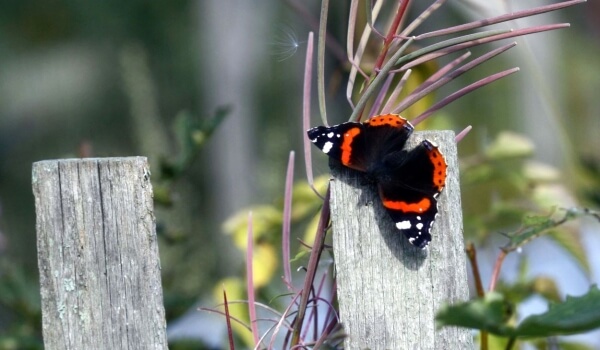
Photo: Butterfly of Russia Admiral
The front wing measures 26-34.5mm, spanning — 50-65 mm. The upper surface is black, velvety-brown.
The characteristic coloration of the forewings:
- there is a small tooth on the outer side of the end;
- a row of white spots goes above parallel to the outer edge;
- slightly closer to the head there is one wide, elongated spot;
- a wide curved carmine red band runs diagonally.
Hindwing coloration:
- a wide carmine red border runs along the lower edge;
- there is a black dot in each of the five segments of the bright stripe;
- a double dot of blue with a black outline is visible in the bottommost corner.
A wavy thin white stripe borders all four wings. The lower surface is paler in coloration, but very pockmarked. Ornamentally similar to the upper surface of the forewings, but they are not so bright, complemented by bluish areas almost in the center of the upper edge. the background is dotted with black, dark brown lines, small circles, grayish stains;
The back of the calf is dark, black or brown, the abdomen is lighter brown or tobacco. The breast is divided into three parts, each of which has a pair of limbs. The role of the oral apparatus is performed by the proboscis. The complex eyes of a butterfly are covered with bristles and have a crystalline structure. The antennae are club-like thickened in the upper part; they serve as one of the sense organs. with their help, nymphalids can catch the slightest fluctuations in the air, smell aromas.
Where does the admiral butterfly live?
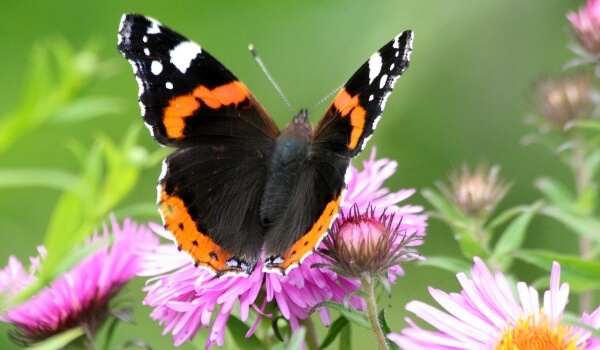
Photo: Butterfly Admiral in Russia
The geographical range of distribution of Vanessa Atlanta extends in the Northern Hemisphere from northern Canada to Guatemala – in the west, from Scandinavia to the European part of Russia, further south to Africa, its northern part, in eastern China. It can be seen in the Atlantic in Bermuda, Azores, Canary Islands, in the Pacific Ocean in Hawaii, and other islands of the Caribbean. The insect was introduced to New Zealand and breeds there.
Nymphalida cannot survive cold winters, but during migrations it can be found from the tundra to the subtropics. Unable to endure extreme frosts, fluttering beauties migrate to the southern regions, to warmer places. This representative of Vanessa loves moist forests, swampy areas, water meadows, gardens with regular irrigation. This is one of the last butterflies that can be found in the north of Europe before the onset of winter. It can live in mountain ranges at altitudes up to 2700 meters.
What does the admiral butterfly eat?
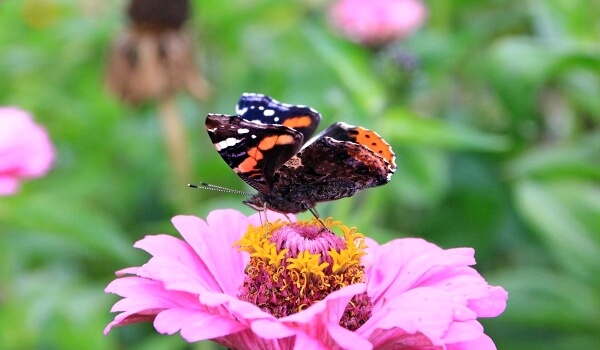
Photo: Admiral Butterfly
Adults feed on fruits, they can be seen on carrion, they love the fermented juice of overripe fruits. Food is also served by sugary liquid secretions of trees, bird droppings. At the end of summer, Vanessas sit on overripe fruits. From flowers, if there is no other food, then they prefer aster, spurge, alfalfa, red clover.
Caterpillars eat leaves of nettle, stinging nettle, and other plants from the Urticaceae family. They live on hops, plants of the thistle genus. The oral apparatus of an adult is unique. Soft proboscis, like a steel clock spring, can open and twist. It is mobile, elastic and adapted to absorb liquid nectars and plant juices.
An interesting fact: On the front legs of an insect there are sensitive villi that are equipped with taste buds, the admiral takes the first “test” when sitting on a fruit or tree sap.
Character and lifestyle features
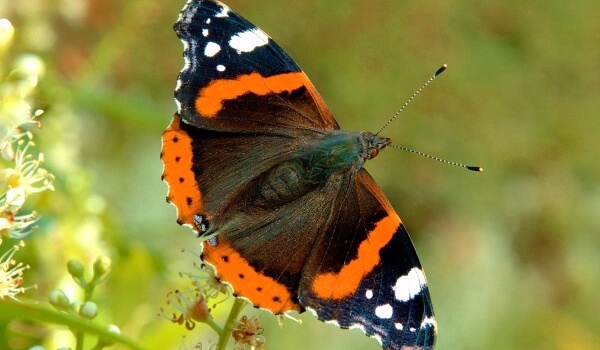
Photo: Butterfly Admiral from Russia
The winged insect has a fast and erratic flight, the speed can reach 15 km/h. When migrating, the admiral travels great distances, and in order not to lose a lot of energy, he rises high into the sky and flies using air currents. Such flights can be significant: from one continent to another.
The butterfly for the winter months, depending on the habitat, falls asleep until spring, appearing already with a brighter color, but they can be seen fluttering on sunny winter days in the southern regions.
Interesting fact: The bright coloring of the wings is necessary for Vanessa atlanta so that individuals of this species can recognize each other from a distance. Up close, they recognize by the smell emitted by androconia.
When some of the insects, hiding in the crevices of the bark or leaves, fall asleep, others set off on their journey to warmer climes and winter there. For winter periods, European individuals choose the north of Africa, and North American individuals choose the islands of the Atlantic. Instances that remain for the winter do not always survive until spring, however, like those that make distant dangerous migrations. The periods of flight may be different, depending on the habitat: from the beginning of May-June to September-October.
Interesting fact: These nymphalids have color vision, they see: yellow, green, blue and indigo. Since admirals do not have lateral filter pigments, they cannot see shades of the orange-red spectrum.
Social Structure and Reproduction
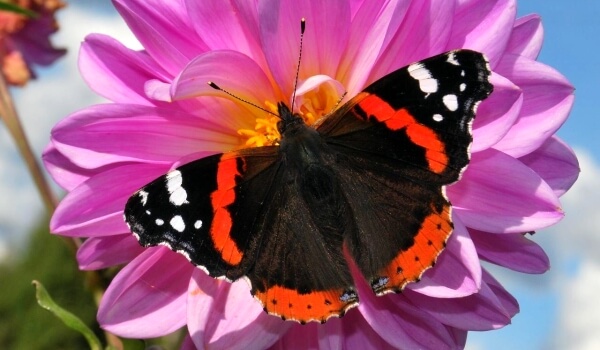
Photo: Butterfly Admiral Russia
Admirals are creatures with a complete transformation, they go through all the stages from an egg to a larva, which turns into a chrysalis, and then is reborn into an adult. Before mating, males persistently look after their chosen ones, while simultaneously repelling the attacks of rivals. They circle their territory up to 30 times per hour. During this time, they manage to interact with other applicants 10-15 times, such activity continues throughout the day.
The area of the site, which has the shape of an oval, is 2.5-7 m wide and 4-13 m long. When an intruder appears, the male drives him away, rising in a vertical spiral to tire the enemy. After expelling the enemy, the owner of the site returns to his territory and continues to patrol it. Only the most hardy individuals are able to conquer a female in order to leave offspring. Males often sit in bright, sunlit areas and wait for the females to fly up.
Interesting fact: Depending on the habitat, admirals can have one, two or three generations of offspring per year.
A green, oval, ribbed egg (about 0.8 mm) is laid by females on the upper part of the leaf of a food plant. A week later, at the exit, the size of the greenish larva is 1.8 mm. As they grow and molt (a total of 5 stages of development), the body length changes to 2.5-3 cm, and the color also changes. It may vary slightly, but most often black with white dots around the body.
The caterpillars have spikes with reddish bases, they are placed in annular segments. There are seven rows of spines along the body. A strip of white or cream-colored spots runs along the sides of the body. The diet of caterpillars is leaves, most often of the nettle family. They hide from enemies in sheets folded in half.
Interesting fact: When growing larvae in different laboratory conditions, at temperatures of about 32 °, the pupal stage lasted 6 days. At 11-18° this time was extended and amounted to 47-82 days. Under warm conditions, the pupae and butterflies that emerged from them were brighter.
At the end of the last stage, the caterpillar stops feeding. Building a house for the next stage of life, she eats the base of the leaf, but leaves veins, folds it in half and glues the edges. The shelter hangs freely on the veins, in it a nondescript, gray-colored chrysalis with short spikes and golden spots is upside down. Its size is about 2.2 cm.
Natural enemies of admiral butterflies
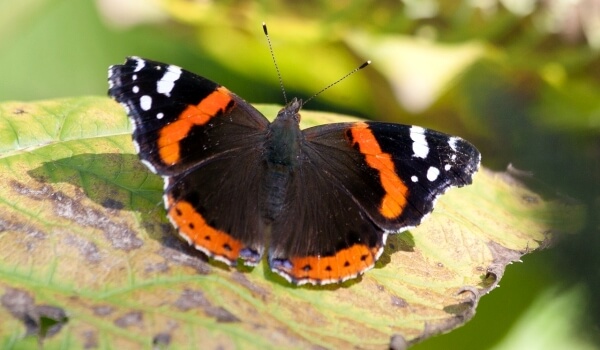
Photo: Admiral Butterfly
Due to their uneven, rapid flutter, these winged creatures are difficult to catch, since it is impossible to predict where they will direct their flight the next moment. Bright admirals are very trusting and can sit on an outstretched hand. When the wings are folded, it is difficult to notice them against the background of the bark of trees where they hide to sleep. They become more available when they drink nectar or become slower before hibernation.
Birds are the main enemies of adults, although some are scared off by bright colors. Among those who can still hunt flying butterflies are bats. The furry appearance of the larvae scares away many who want to eat. Of all the birds, perhaps only cuckoos risk diversifying their diet with caterpillars. Rodents also include these Lepidoptera in their menu, regardless of the stage of development. Amphibians and reptiles of various species prey on Vanessa atlanta and its larvae. Caterpillars have their enemies among insects.
They can be eaten by representatives of:
- coleoptera;
- spiders;
- dragonflies;
- wasps;
- mantises;
- ants.
Photo: Red Admiral Butterfly
Butterfly admiral occupies a wide range on the North American continent, in Europe, North Africa, East Asia. Here, this species is not threatened. Good preservation in the habitat is facilitated by: the migratory nature of the life of an insect, adaptability to different temperature conditions. If for some reason, for example, due to a frosty winter, part of the population dies, then individuals migrating from warmer regions take its place.
In Russia, this species is found in the forests of the central European part, Karelia, the Caucasus, the Urals. In 1997, these Lepidoptera were included in the Red Book List of the Russian Federation. Soon the population increased, they were excluded from the list of protected. Only in the Smolensk region. they have a fourth category, the status of declining, but not rare.
Negative consequences for vanessa atlanta, however, as for many living creatures, are:
- clearing forest areas ;
- expanding farmland by plowing meadows;
- using chemicals to treat plantings.
Preserving forests and water meadows, favorable conditions for life nymphalids can maintain the population size unchanged. Butterfly admiral – one of the most beautiful species on our planet. The harsh nature of Russia is not so rich in bright butterflies, Vanessa atalanta is one of them. From early spring to late autumn, she pleases the eye, fluttering from flower to flower. A harmless insect does not harm cultivated plants, and therefore, when you see a hairy caterpillar on a nettle, do not rush to crush it.

